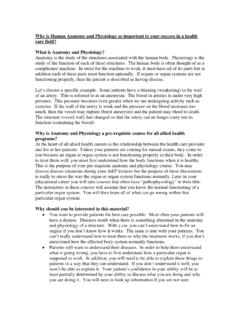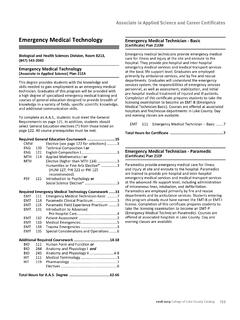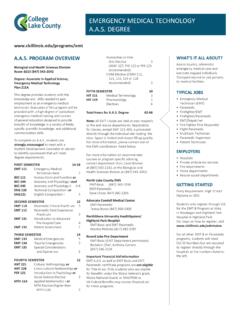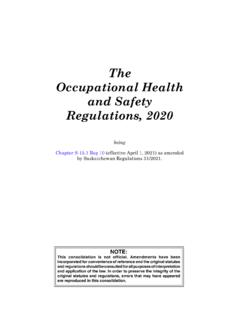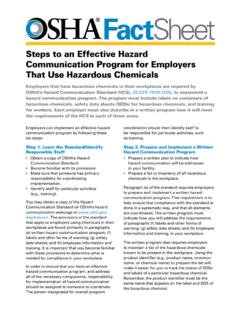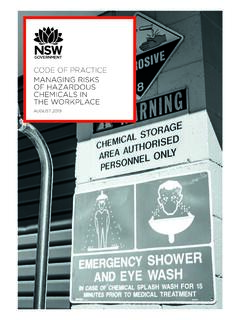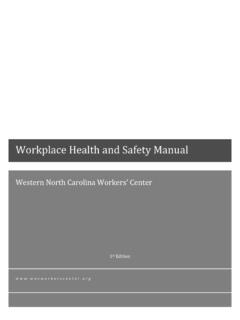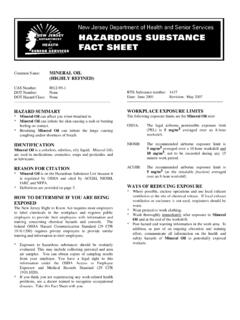Transcription of HAZARDOUS MATERIALS MANAGEMENT PROCEDURES
1 COLLEGE OF LAKE COUNTY HAZARDOUS MATERIALS MANAGEMENT PROCEDURES Drafted by Kevin Lowry Environmental Health and Safety Manager College of Lake County 3/25/14 CLC HAZARDOUS MATERIALS MANAGEMENT PROCEDURES 2 Table of Contents A. Objective .. pg. 3 B. Scope .. pg. 3 C. References .. pg. 3 D. Responsibilities .. pg. 3 Section I: Hazard Communication Program .. pg. 3 A. HAZARDOUS Chemical Definition .. pg. 3 B. Employee Information and Training .. pg. 4 C. Safety Data Sheets (SDS) .. pg. 5 D. Container Labeling .. pg. 6 E. List of HAZARDOUS Substances .. pg. 7 F. Non-Routine Tasks .. pg. 7 G. Informing Contractors .. pg. 7 H. Laboratory Requirements .. pg. 8 I. Plan Administration .. pg. 8 J. Health Hazard Definitions.
2 Pg. 8 Section II: Inventory, Handling, Storage, and Disposal of HAZARDOUS MATERIALS .. pg. 8 A. General Laboratory Practices .. pg. 8 B. Chemical Inventory .. pg. 9 C. Handling HAZARDOUS MATERIALS .. pg. 9 D. Storage .. pg. 10 E. Disposal of HAZARDOUS Waste .. pg. 11 F. Storage of Corrosives .. pg. 12 G. Storage of Compressed Gases .. pg. 12 H. Disposal of HAZARDOUS Waste .. pg. 16 Appendices Appendix A (OSHA Pictograms) .. pg. 17 Appendix B ( HAZARDOUS Chemical Inventory Form) .. pg. 18 CLC HAZARDOUS MATERIALS MANAGEMENT PROCEDURES 3 A. Objective The HAZARDOUS MATERIALS MANAGEMENT PROCEDURES are guidelines to ensure that all employees and students receive adequate information relevant to the possible hazards which may be associated with the various HAZARDOUS substances used at the College.
3 The procedure covers the following topics: communication, inventory; handling; storage; and disposal of HAZARDOUS MATERIALS . B. Scope This program covers all potential workplace exposures involving HAZARDOUS substances as defined by Federal, State and local regulations. This includes all employees, students, visitors, and contractors of the College. This does not pertain to the Chemical Hygiene Plan for chemical and biological labs at the College. C. References Department of Labor, Occupational Health and Safety Administration (OSHA) 29 Code of Federal Regulations , Illinois Department of Labor 820 ILCS 225 Health and Safety Act. In 2012, OSHA revised the Hazard Communication Standard to align with the UN system of classifying chemicals. Starting in 2015, chemical manufacturers and distributors will be required to comply with new labeling of chemicals and a new format to the Safety Data Sheet (SDS) standard.
4 For this document, all former material Safety Data Sheets (MSDS) will now be referred to as Safety Data Sheets (SDS). D. Responsibilities Supervisors and department chairs must inform employees, students and visitors of HAZARDOUS MATERIALS used in the area. Supervisors and department chairs must make sure that Safety (SDS) are readily available for all HAZARDOUS chemicals used in the work area. An inventory of HAZARDOUS substances shall also be maintained for information on the amount and location of HAZARDOUS substances. Supervisors and department chairs must ensure containers of HAZARDOUS substances are always properly labeled, and that HAZARDOUS MATERIALS are inventoried, stored, handled, and disposed of properly. Employees working with HAZARDOUS MATERIALS must attend Hazard Communication training to ensure they understand the hazards and how to read a SDS.
5 T h e Environmental Health and Safety Manager or Laboratory Chemical Hygiene Officer can provide training and assistance in Hazard Communications. Section I. Hazard Communication Program A. HAZARDOUS material Definition A HAZARDOUS and/or toxic material is defined by OSHA as any chemical that is a health hazard or a physical hazard. HEALTH HAZARD: OSHA defines a health hazard as a chemical for which there is CLC HAZARDOUS MATERIALS MANAGEMENT PROCEDURES 4 statistically significant evidence based on at least one study conducted in accordance with established scientific principles that acute or chronic health effects may occur in exposed employees. Chemicals covered by this definition include carcinogens, toxic or highly toxic agents, reproductive toxins, irritants, corrosives, sensitizers, hepatotoxins, nephrotoxins, neurotoxins, agents that act on the hematopoietic system, and agents that damage the lungs, skin, eyes, or mucous membranes.
6 PHYSICAL HAZARD: OSHA defines a physical hazard as a chemical for which there is scientifically valid evidence that it is a combustible liquid, a compressed gas, explosive, flammable, an organic peroxide, an oxidizer, pyrophoric, unstable (reactive), or water-reactive. ADDITIONAL HAZARDOUS MATERIALS : The broad definition OSHA uses to define HAZARDOUS chemicals includes not only generic chemicals, but also paints, cleaning compounds, inks, dyes, and many other common substances. Chemical manufacturers and importers are required to determine if the chemicals they produce or repackage meet the definition of a HAZARDOUS chemical. A chemical mixture may be considered as a whole or by its ingredients to determine its hazards. It may be considered as a whole if it has been tested as a whole and a MSDS/SDS has been issued accordingly.
7 Otherwise the mixture must be evaluated by its components. If the mixture contains or more of a HAZARDOUS chemical or of an ingredient listed as a carcinogen or suspected carcinogen, the whole mixture is assumed to have the same health and/or carcinogenic hazards as its components. B. Employee Information & Training All employees that work with HAZARDOUS substances will attend an orientation meeting for information and training on the following items prior to starting work with HAZARDOUS substances; (Training CHECKLIST is to be completed and kept in employee file). An overview of the requirements of the Hazard Communication Standard, including their rights under this regulation. Information on where HAZARDOUS substances are present in their work areas.
8 Information regarding the use of HAZARDOUS substances in their specific work areas. The location and availability of the written Hazard Communication Program. Subsequent to this, the program will be available from managers and also from the Manager of Environmental Health & Safety. The physical and health aspects of the substances in use. Methods and observation techniques used to determine the presence or release of HAZARDOUS substances in the work area. The controls, work practices and personal protective equipment, which are available for protection against possible exposure. Emergency and first aid PROCEDURES to follow if employees are exposed to HAZARDOUS substances and the signs and symptoms of overexposure to HAZARDOUS chemicals in the workplace .
9 How to read labels and Safety Data Sheets (SDS) to obtain the appropriate hazard information. CLC HAZARDOUS MATERIALS MANAGEMENT PROCEDURES 5 Employees whose duties include handling or otherwise managing HAZARDOUS wastes will receive training specific to those tasks that involve waste handling in accordance with state and federal HAZARDOUS waste regulations. Training is required at the time of initial assignment and whenever a new chemical hazard is introduced into the work area that an employee has not previously received training on. Information and training may be designed to cover categories of hazards or specific chemicals. It is most important that all of our employees understand the information given in the orientation meetings.
10 Questions regarding this information should be directed to the Manager of Environmental Health & Safety. When new substances are introduced into the workplace the Department manager will review the above items with you as they are related to the new MATERIALS . The department manager will relay all the above information to new employees, who will be working with HAZARDOUS substances, prior to their starting work. C. Safety Data Sheets (SDS) The 2012 Hazard Communications Revision require the following 16 sections, in this order: 1. Identification includes product identifier; manufacturer or distributor name, address, phone number; emergency phone number; recommended use; restrictions on use. 2. Hazard(s) identification includes all hazards regarding the chemical; required label elements.

